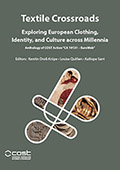Center, Textile Research

Textile Crossroads: Exploring European Clothing, Identity, and Culture across Millennia
Date of this Version
2024
Document Type
Article
Citation
In Textile Crossroads: Exploring European Clothing, Identity, and Culture across Millennia. Anthology of COST Action “CA 19131 – EuroWeb”. Kerstin Droß-Krüpe, Louise Quillien, & Kalliope Sarri, Editors. Zea Books, Lincoln, Nebraska, 2024.
DOI: 10.32873/unl.dc.zea.1817
Abstract
In 2022–2024, textile and fashion scholars came together to write an anthology sharing a new vision of European history as seen through textiles, in the COST Action EuroWeb. During this period, the continent was still dealing with the consequences of the COVID-19 pandemic and was then faced with Russia’s full-scale invasion of Ukraine in February 2022. Contemporary European history will be markedly defined by the ongoing war in Ukraine. One remarkable aspect of this conflict is the way textiles and dress appear daily in a variety of media outlets, mobilized as visual and semiotic means to communicate issues of war and national identity, especially by Ukraine. The first material embodiment signaling Ukrainian resistance to the Russian invasion is the national blue and yellow flag. As a color-coded textile marker, in Ukraine and internationally, the flag appears at rallies in support of the nation’s efforts to defend itself. Beyond the flag, this essay offers a critical reflection on how textiles and garments are used in times of conflict as narrative tools of self-identification, to enact and express a sense of cultural belonging and resistance.
Throughout history, textiles and clothes have been “auxiliary materials for weaponry as well as for protection” in the context of war. In modern history, they are also integral components of a nation’s propaganda efforts toward the local population, as well as in diplomacy and international communication. For example, leaders of the Khmer Rouge dictatorial regime in Cambodia instituted an outfit, comprised of a black cotton garb inspired by farmers working in rice fields, a red and white krama scarf, and a Chinese-style cap, to convey ideas of a uniform peasant-driven Marxist society within and outside the country.
Through our daily choice of clothing, we wear a tactile manifestation of identity and values, and global citizens sympathetic to either side of the conflict can physically and materially express their political views via clothing. Textile and fashion research commonly draws from museum collections, scholarly publications, and archaeological sources. This essay also engages with multi-modal forms of personal, public, and cultural expression, such as artworks, and garments, as well as podcast interviews, social media publications, and news pieces from commercial media outlets. This diversity of sources helps us to closely document how textiles and fashion have been showcased, discussed, and reclaimed in the recent political climate. They involve a range of actors, including craft communities, activists, civilians, political personalities, and heritage experts, which illuminate the many ways of negotiating Ukraine’s current situation.
In this sense, this paper does not aim to provide a comprehensive overview of Ukrainian textile cultural heritage and history, or to assess its vast diversity of regional crafts. Our perspective is not essentialist or aiming to demonstrate direct links between today and the past; rather, we observe in this paper how ‘dressing the present’ is situated in and draws from multiple ideas of a textile past of Ukraine. We attempt to observe and document, nearly in real time, from February 2022 to mid-2023, the configuration and politics of textiles and fashion in the images of war shared in the media stream, and their significance to issues of cultural heritage, nationhood, and selfhood. Identifying these major textile phenomena, which have emerged during the war, reveals shifting, enduring, and conflicting narratives about Ukrainian cultural heritage and textile material culture. They are discussed in five interconnected sections: Zelenskyy’s attire of power and folklore, the vyshyvanka shirt’s rise to prominence, the revival of embroidery in individual women’s practice, resistance through community activism, and the necessity to preserve the archaeological and historical heritage of textiles in Ukraine in the face of destruction.
In the case of Russia’s full-scale invasion of Ukraine in 2022, dress has become a potent communication device in mass media, for Ukrainian people and in the international community. Ukraine’s President Zelenskyy, an experienced and effective communicator, initiated this movement by using his persona and changing his attire to embody the figure of a political leader actively engaged in the defense of his country’s freedom.
Included in
Ancient History, Greek and Roman through Late Antiquity Commons, Archaeological Anthropology Commons, Classical Archaeology and Art History Commons, Classical Literature and Philology Commons, Eastern European Studies Commons, European History Commons, European Languages and Societies Commons, Fiber, Textile, and Weaving Arts Commons, History of Science, Technology, and Medicine Commons, Human Geography Commons, Museum Studies Commons, Place and Environment Commons, Social and Cultural Anthropology Commons, Women's Studies Commons


Comments
Copyright © 2024 by the authors.